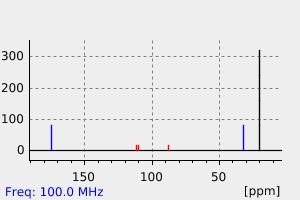(2-甲基丙亚基)丙二腈 | 13134-03-7
中文名称
(2-甲基丙亚基)丙二腈
中文别名
——
英文名称
isobutylidene-malononitrile
英文别名
2-(2-methylpropylidene)malononitrile;Propanedinitrile, (2-methylpropylidene)-;2-(2-methylpropylidene)propanedinitrile
CAS
13134-03-7
化学式
C7H8N2
mdl
——
分子量
120.154
InChiKey
QJVQEWMEWWZHHF-UHFFFAOYSA-N
BEILSTEIN
——
EINECS
——
-
物化性质
-
计算性质
-
ADMET
-
安全信息
-
SDS
-
制备方法与用途
-
上下游信息
-
文献信息
-
表征谱图
-
同类化合物
-
相关功能分类
-
相关结构分类
计算性质
-
辛醇/水分配系数(LogP):1.5
-
重原子数:9
-
可旋转键数:1
-
环数:0.0
-
sp3杂化的碳原子比例:0.43
-
拓扑面积:47.6
-
氢给体数:0
-
氢受体数:2
安全信息
-
海关编码:2926909090
SDS
反应信息
-
作为反应物:描述:(2-甲基丙亚基)丙二腈 在 N-溴代丁二酰亚胺(NBS) 、 过氧化苯甲酰 作用下, 以 四氯化碳 为溶剂, 反应 2.0h, 生成 2-bromo-2-methylpropylidenemalononitrile参考文献:名称:通过迈克尔诱导闭环 (MIRC) 反应合成取代的环丙基膦酸酯摘要:通过迈克尔诱导的亚磷酸三烷基酯与相应的β-溴亚烷基氰基乙酸酯和丙二酸酯的闭环,以中等至良好的产率制备了多种环丙基膦酸酯。DOI:10.1055/s-2002-32587
-
作为产物:参考文献:名称:Minute Synthesis of Electrophilic Alkenes under Microwave Irradiation摘要:在无溶剂条件下,通过仔细调整哌啶的用量,并借助微波辐照,3至15分钟内即可有效地实现活性亚甲基化合物1与羰基衍生物2的缩合反应,生成Knoevenagel产物3,产率良好至极佳。DOI:10.1055/s-1994-25453
文献信息
-
Molybdenum carbide as an efficient and durable catalyst for aqueous Knoevenagel condensation作者:Mina Tavakolian、Mohammad Mahdi NajafpourDOI:10.1039/c9nj04647j日期:——and benign catalysts were used for the Knoevenagel condensation reaction. Among the compounds (Mo2C, MoS2, MoB, MoSi2), molybdenum carbide showed efficient performance for the Knoevenagel condensation in aqueous media at room temperature, affording the corresponding products in high yields within a short reaction time. Notably, using this commercially available heterogeneous catalyst, the deaceta
-
Porous Organic Polymers Constructed from Tröger's Base as Efficient Carbon Dioxide Adsorbents and Heterogeneous Catalysts作者:Zhifeng Dai、Yongquan Tang、Qi Sun、Xiaolong Liu、Xiangju Meng、Feng Deng、Feng-Shou XiaoDOI:10.1002/cctc.201701534日期:2018.4.24a radical solvothermal polymerization method, we synthesized two porous organic polymers based on Tröger's base (POP‐TB and POP‐Me‐TB) from the corresponding vinyl‐functionalized monomers (2,8‐divinyl‐6H,12H‐5,11‐methanodibenzo[b,f]diazocine and 2,8‐divinyl‐4,10‐dimethly‐6H,12H‐5,11‐ethanodibenzo[b,f]diazocine; v‐TB and v‐Me‐TB). The structure and porosity of these polymers are verified by using solid‐state通过自由基溶剂热聚合方法,我们从相应的乙烯基官能化单体(2,8-二乙烯基-6 H,12 H- 5, 11-甲基二苯并[ b,f ]重氮电影和2,8-二乙烯基-4,10-二甲基-6 H,12 H -5,11-乙二苯并[ b,f ]重氮电影; v-TB和v-Me-TB 。通过使用固态NMR光谱,元素分析,SEM,TEM,N 2吸附等温线和CO 2验证了这些聚合物的结构和孔隙率吸附测试。它们具有较高的表面积和适中的孔体积,可提供较高的CO 2吸附能力(对于POP-TB和POP-Me-TB,在273 K时分别为90和71 mg g -1,在298 K时分别为60和44 mg g -1,分别在1 bar的CO 2压力下进行。此外,它们在基准Knoevenagel反应中具有出色的催化活性以及作为非均相催化剂的高度稳定性。
-
Critical assessment of the efficiency of chitosan biohydrogel beads as recyclable and heterogeneous organocatalyst for C–C bond formation作者:Dennis Kühbeck、G. Saidulu、K. Rajender Reddy、David Díaz DíazDOI:10.1039/c1gc15925a日期:——The effectiveness of neutral pH chitosan hydrogel beads (CSHB) as a green organocatalyst for a variety of CâC bond forming reactions (i.e. aldol reaction, Knoevenagel condensation, nitroaldol (Henry) reaction, Michael addition) has been comprehensively evaluated. Reaction rates, conversions and selectivities were studied as a function of a series of input variables including size, pH and reactive surface area of the beads, catalyst loading, temperature, molecular weight of the biopolymer, concentration, solvent system and molar ratio of reactants. Moreover, the catalytic biohydrogel beads were characterized by a variety of techniques including, among others, SEM, FT-IR, TGA and DSC.
-
Catalytic Amphiphilic Allylation via Bis-π-allylpalladium Complexes and Its Application to the Synthesis of Medium-Sized Carbocycles作者:Hiroyuki Nakamura、Kouichi Aoyagi、Jae-Goo Shim、Yoshinori YamamotoDOI:10.1021/ja002931g日期:2001.1.11,7-octadiene derivatives 6a−k, in good to high yields. The reaction of certain imines 9 with 4 and 5a under similar conditions as above afforded the bis-allylated amines, N-allyl-N-3-butene-1-amine derivatives 10a−f, in good to high yields. The bis-allylation reactions most probably proceed through bis-π-allylpalladium intermediate 2. The above intermolecular bis-allylation was extended to the intramolecular在钯催化剂的存在下,某些活化的烯烃 3 与烯丙基三丁基锡烷 (4) 和烯丙基氯 (5a) 的反应得到双烯丙基化产物,1,7-辛二烯衍生物 6a-k,产率良好至高。某些亚胺 9 与 4 和 5a 在与上述类似条件下的反应以良好至高产率提供双烯丙基化胺、N-烯丙基-N-3-丁烯-1-胺衍生物 10a-f。双烯丙基化反应最有可能通过双-π-烯丙基钯中间体2进行。上述分子间双烯丙基化反应扩展到分子内反应。8-氯-2,6-辛二烯基三丁基锡烷 (17a) 与活化烯烃 3 的反应得到区域异构环加合物、[8+2] 和 [4+2] 环加成产物的混合物。区域异构比例取决于溶剂和活化烯烃 β 位的电子密度。通常,[8+2] 环加合物 18 主要在 CH2Cl2 中获得,而 [4+2] 加合物 24 和 25 主要在 中产生。
-
Knoevenagel, wittig and wittig-horner reactions in the presence of magnesium oxide or zinc oxide.作者:Hélène Moison、Françoise Texier-Boullet、André FoucaudDOI:10.1016/s0040-4020(01)89986-5日期:1987.1Knoevenagel and Wittig-Horner reactions in solid-liquid systems, with magnesium oxide or zinc oxide as catalyst. When Wittig-Horner reaction is competitive with Knoevenagel reaction, the catalyst can be modified to give a highly selective reaction ; the addition of dimethylsulfoxide on MgO or heiamethylphosphoric triamide on ZnO gives more efficient catalysts for the Wittig-Homer reaction. The addition of a small
表征谱图
-
氢谱1HNMR
-
质谱MS
-
碳谱13CNMR
-
红外IR
-
拉曼Raman
-
峰位数据
-
峰位匹配
-
表征信息
同类化合物
(乙腈)二氯镍(II)
(R)-(-)-α-甲基组胺二氢溴化物
(N-(2-甲基丙-2-烯-1-基)乙烷-1,2-二胺)
(4-(苄氧基)-2-(哌啶-1-基)吡啶咪丁-5-基)硼酸
(11-巯基十一烷基)-,,-三甲基溴化铵
鼠立死
鹿花菌素
鲸蜡醇硫酸酯DEA盐
鲸蜡硬脂基二甲基氯化铵
鲸蜡基胺氢氟酸盐
鲸蜡基二甲胺盐酸盐
高苯丙氨醇
高箱鲀毒素
高氯酸5-(二甲氨基)-1-({(E)-[4-(二甲氨基)苯基]甲亚基}氨基)-2-甲基吡啶正离子
高氯酸2-氯-1-({(E)-[4-(二甲氨基)苯基]甲亚基}氨基)-6-甲基吡啶正离子
高氯酸2-(丙烯酰基氧基)-N,N,N-三甲基乙铵
马诺地尔
马来酸氢十八烷酯
马来酸噻吗洛尔EP杂质C
马来酸噻吗洛尔
马来酸倍他司汀
顺式环己烷-1,3-二胺盐酸盐
顺式氯化锆二乙腈
顺式吡咯烷-3,4-二醇盐酸盐
顺式双(3-甲氧基丙腈)二氯铂(II)
顺式3,4-二氟吡咯烷盐酸盐
顺式1-甲基环丙烷1,2-二腈
顺式-二氯-反式-二乙酸-氨-环己胺合铂
顺式-二抗坏血酸(外消旋-1,2-二氨基环己烷)铂(II)水合物
顺式-N,2-二甲基环己胺
顺式-4-甲氧基-环己胺盐酸盐
顺式-4-环己烯-1.2-二胺
顺式-4-氨基-2,2,2-三氟乙酸环己酯
顺式-3-氨基环丁烷甲腈盐酸盐
顺式-2-羟基甲基-1-甲基-1-环己胺
顺式-2-甲基环己胺
顺式-2-(苯基氨基)环己醇
顺式-2-(苯基氨基)环己醇
顺式-2-(氨基甲基)-1-苯基环丙烷羧酸盐酸盐
顺式-1,3-二氨基环戊烷
顺式-1,2-环戊烷二胺二盐酸盐
顺式-1,2-环戊烷二胺
顺式-1,2-环丁腈
顺式-1,2-双氨甲基环己烷
顺式--N,N'-二甲基-1,2-环己二胺
顺式-(R,S)-1,2-二氨基环己烷铂硫酸盐
顺式-(2-氨基-环戊基)-甲醇
顺-2-戊烯腈
顺-1,3-环己烷二胺
顺-1,3-双(氨甲基)环己烷







